Service Alert
Le 1 juillet, Fête du Canada
À l’occasion de la Fête du Canada, le CAÉB sera fermé le mardi 1 juillet. Les heures d’opération régulières reprendront le mercredi 2 juillet. Nous vous souhaitons un bon congé!
À l’occasion de la Fête du Canada, le CAÉB sera fermé le mardi 1 juillet. Les heures d’opération régulières reprendront le mercredi 2 juillet. Nous vous souhaitons un bon congé!
Articles 1489581 à 1489600 sur 1499702
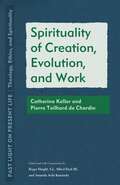
Par Catherine Keller and Pierre Teilhard de Chardin. 1957
Two developments that occurred over the course of the nineteenth century had a strong impact on Christian theology. The first…
was a deepening of the implications of historical consciousness, and the second was the impact of science on Christian self-understanding. Marx’s sociology of knowledge symbolizes the first; Darwin’s analysis of evolution symbolizes the second. These intellectual developments gave rise to various forms of process philosophy and theology. Within this context, a dialogue between Christian theology and evolution has yielded dramatically new convictions and practices in Christian spirituality, especially relative to ecology. For more than three decades Catherine Keller has been reflecting on the intellectual and practical effects that an internalization of the dynamic character of reality should have upon the practice of Christian life. Her text illustrates the basic framework of dynamic becoming that science demands, whether or not one is formally a process thinker. Pierre Teilhard de Chardin was an earlier figure who was more zeroed in on the phenomenon of evolution, which he encountered in a distinct way as a Christian scientist trained in geology and paleontology, as distinct from biology or genetics. Evolution explicitly informs his spirituality. These two different Christian writers, the one representing the imaginative framework of being as process and becoming, the other focused on how evolution affects intentional spiritual life, open new perspectives on the spiritual character of people’s active lives of work and creativity in the world that science presents to us.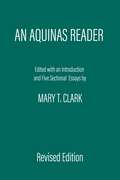
Par Mary T. Clark. 2000
Available in a new digital edition with reflowable text suitable for e-readersThis new edition of An Aquinas Reader contains in…
one closely knit volume representative selections that reflect every aspect of Aquinas’s philosophy. Divided into three section – Reality, God, and Man – this anthology offers an unrivaled perspective of the full scope and rich variety of Aquinas’s thought. It provides the general reader with an overall survey of one of the most outstanding thinks or all time and reveals the major influence he has had on many of the world’s greatest thinkers. This revised third edition of Clark’s perennial still has all of the exceptional qualities that made An Aquinas Reader a classic, but contains a new introduction, improved format, and an updated bibliography.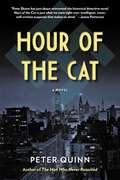
Par Peter Quinn. 2021
It’s just another murder, one of the hundreds of simple homicides in 1939: A spinster nurse is killed in her…
apartment; a suspect is caught with the murder weapon and convicted. Fintan Dunne, the P.I. lured onto the case and coerced by conscience into unraveling the complex setup that has put an innocent man on Death Row, will soon find that this is a murder with tentacles which stretch far beyond the crime scene . . . to Nazi Germany, in fact; following it to the end leads him into a murder conspiracy of a scope that defies imagination. The same clouds are rolling over Berlin, where plans for a military coup are forming among a cadre of Wehrmacht officers. Admiral Wilhelm Canaris, head of the Military Intelligence, is gripped by a deadly paralysis: He is neither with the plotters nor against them. Joining them in treason would violate every value he holds as an officer. Betraying the plotters to the Gestapo Chief, Reinhard Heydrich, might just forsake the country’s last hope to avert utter destruction and centuries of shame. Heydrich is suspicious. With no limits to Hitler’s manic pursuit of territorial expansion, with crimes against the people candy-coated as racial purification, the “hour of the cat” looms when every German conscience must make a choice. When Canaris receives an order to assist in a sinister covert operation on foreign shores, his hour has come. Hour of the Cat is a stunning achievement: tautly suspenseful, hauntingly memorable, and brilliantly authentic.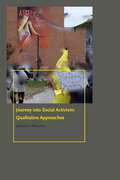
Academic study of social activism and social movements has become increasingly prevalent over the years; this is due in large…
part to the fact that activists have captured public imagination and gained substantial influence in political discourse. For instance, Occupy Wall Street activists, Tea Party activists, and activists affiliated with the Arab Spring have transformed political debates and have become the focus of mainstream news media coverage about a variety of different political topics.Journey into Social Activism explicates the philosophical foundations of the study of activism and illustrates four different research sites in which activism can be observed and studied: organizations, networks, events, and alternative media. The book will introduce students and scholars to important qualitative approaches to the study of social activism within these four research sites, which is based entirely on successful research projects that have been conducted and published in recent years. Ultimately, this book will prove integral to any students and scholars who wish to use qualitative methods for their research endeavors concerning socialactivism in contemporary society.
Par Rosalind Morris. 2025
Poetry that weaves personal narratives with deep political insights, masterfully exploring the intricate intersections of history, philosophy, and emotionIn this…
debut collection, renowned scholar Rosalind Morris spans the lyrical landscapes of personal experience and global political dilemmas. Organized into four distinct sections, each featuring seven poems that vary in style and content, For Lack of a Dictionary reflects the diverse facets of human complexity and the struggle to find a language capable of addressing them. Beginning with a mythopoetic exploration of the self and progressing through varied voices and forms—from the epistolary and the erotic to the elegiac—the collection navigates the absences and presences that shape our interpersonal connections. From Homer’s Iliad to Hobbes’s Leviathan, and from the intimate letters of the Rosenbergs to the television broadcasts of lunar landings, Morris revisits epic figures of classical literature with a contemporary voice, concluding with poignant reflections on personal loss and the seductive allure of magical thinking in times of grief.In the tradition of Adrienne Rich and Muriel Rukeyser, Morris engages in a dialogue that challenges and enlightens, positioning For Lack of a Dictionary as a profound commentary on the intersections of personal and political realms.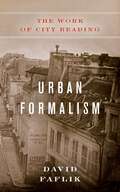
Par David Faflik. 2020
Urban Formalism radically reimagines what it meant to “read” a brave new urban world during the transformative middle decades of…
the nineteenth century. At a time when contemporaries in the twin capitals of modernity in the West, New York and Paris, were learning to make sense of unfamiliar surroundings, city peoples increasingly looked to the experiential patterns, or forms, from their everyday lives in an attempt to translate urban experience into something they could more easily comprehend. Urban Formalism interrogates both the risks and rewards of an interpretive practice that depended on the mutual relation between urbanism and formalism, at a moment when the subjective experience of the city had reached unprecedented levels of complexity.This book not only provides an original cultural history of forms. It posits a new form of urban history, comprising the representative rituals of interpretation that have helped give meaningful shape to metropolitan life.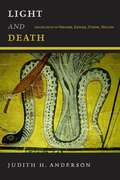
Par Judith H. Anderson. 2017
Light figures being; darkness, death. Bridging mathematical science, semantics, rhetoric, grammar, and major poems, Judith H. Anderson seeks to negotiate…
writings from multiple disciplines in the shared terms of poiesis and figuration rather than as cultural opposites. Analogy, a type of metaphor, has always been the connector of the known to the unknown, the sensible to the infinite. Anderson’s study moves from the figuration of light and death to the history of analogy and its pertinence to light in physics and metaphysics, from Kepler to Donne, Spenser, and Milton. Topics proliferate: creativity, optics, the relation of literature to science, the methodology of thought and argument, and the processes of narrative, discovery, and interpretation.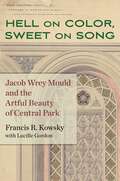
Par Francis R. Kowsky. 2023
WINNER, VICTORIAN SOCIETY IN AMERICA BOOK AWARDWINNER, 2024 PUBLICATION PRIZE, FRIENDS OF THE UPPER EAST SIDE HISTORIC DISTRICTSReveals new and…
previously unknown biographical material about an important figure in nineteenth-century American architecture and music.Jacob Wrey Mould is not a name that readily comes to mind when we think of New York City architecture. Yet he was one-third of the party responsible for the early development of the city’s Central Park. To this day, his sculptural reliefs, tile work, and structures in the Park enthrall visitors. Mould introduced High Victorian architecture to NYC, his fingerprint most pronounced in his striking and colorful ornamental designs and beautiful embellishments found in the carved decorations and mosaics at the Bethesda Terrace. Resurfacing the forgotten contributions of Mould, Hell on Color, Sweet on Song presents a study of this nineteenth-century American architect and musical genius.Jacob Wrey Mould, whose personal history included a tie to Africa, was born in London in 1825 and trained there as an architect before moving to New York in 1852. The following year, he received the commission to design All Souls Unitarian Church. Nicknamed “the Church of the Holy Zebra,” it was the first building in America to display the mix of colorful materials and medieval Italian inspiration that was characteristic of High Victorian Gothic architecture. In addition to being an architect and designer, Mould was an accomplished musician and prolific translator of opera librettos. Yet anxiety over money and resentment over lack of appreciation of his talents soured Mould’s spirit. Unsystematic, impractical, and immune from maturity, he displayed a singular indifference to the realities of architecture as a commercial enterprise. Despite his personal shortcomings, he influenced the design of some of NYC’s revered landmarks, including Sheepfold, the Metropolitan Museum of Art, the American Museum of Natural History, the City Hall Park fountain, and the Morningside Park promenade. From 1875 to 1879, he worked for Henry Meiggs, the “Yankee Pizarro,” in Lima, Peru.Resting on the foundation of Central Park docent Lucille Gordon’s heroic efforts to raise from obscurity one of the geniuses of American architecture and a significant contributor to the world of music in his time, Hell on Color, Sweet on Song sheds new light on a forgotten genius of American architecture and music.Funding for this book was provided by: Furthermore: a program of the J. M. Kaplan Fund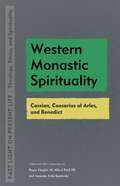
Par Roger Haight, Alfred Pach, and Amanda Avila Kaminski. 2019
Western Monastic Spirituality presents three authors as individuals, certainly, but also as textual informants who, like road markers, represent a…
line of the development of a Western monastic spiritual tradition. John Cassian (ca. 360–435) helped bring the wisdom of northern Egyptian ascetical life of the late fourth century to southern France in the early fifth century. Caesarius of Arles (468/470–542), drawing on his own monastic experience and Augustine’s monastic rule, composed a rule for a women’s monastery in the city of Arles. Not many years later, Benedict wrote the most influential rule in Western monasticism, one that still regulates the lives of monks today all over the world. These three texts, when looked at serially and together, offer a theology of monastic spirituality, an example of a relatively short but comprehensive early monastic rule, and a present day Benedictine interpretation of how Benedict’s monastic spirituality can be summed up in a short present day digest of his rule. Reflection on early Western monasticism retrieves some basic Christian spiritual values that should inform life today outside the monastery in a busy, secular culture.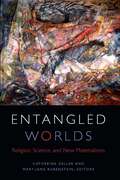
Par Catherine Keller and Mary-Jane Rubenstein. 2017
Historically speaking, theology can be said to operate “materiaphobically.” Protestant Christianity in particular has bestowed upon theology a privilege of…
the soul over the body and belief over practice, in line with the distinction between a disembodied God and the inanimate world “He” created. Like all other human, social, and natural sciences, religious studies imported these theological dualisms into a purportedly secular modernity, mapping them furthermore onto the distinction between a rational, “enlightened” Europe on the one hand and a variously emotional, “primitive,” and “animist” non-Europe on the other. The “new materialisms” currently coursing through cultural, feminist, political, and queer theories seek to displace human privilege by attending to the agency of matter itself. Far from being passive or inert, they show us that matter acts, creates, destroys, and transforms—and, as such, is more of a process than a thing. Entangled Worlds examines the intersections of religion and new and old materialisms. Calling upon an interdisciplinary throng of scholars in science studies, religious studies, and theology, it assembles a multiplicity of experimental perspectives on materiality: What is matter, how does it materialize, and what sorts of worlds are enacted in its varied entanglements with divinity? While both theology and religious studies have over the past few decades come to prioritize the material contexts and bodily ecologies of more-than-human life, Entangled Worlds sets forth the first multivocal conversation between religious studies, theology, and the body of “the new materialism.” Here disciplines and traditions touch, transgress, and contaminate one another across their several carefully specified contexts. And in the responsiveness of this mutual touching of science, religion, philosophy, and theology, the growing complexity of our entanglements takes on a consistent ethical texture of urgency.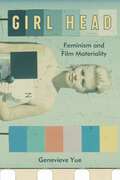
Par Genevieve Yue. 2021
Girl Head shows how gender has had a surprising and persistent role in film production processes, well before the image…
ever appears onscreen.For decades, feminist film criticism has focused on issues of representation: images of women in film. But what are the feminist implications of the material object underlying that image, the filmstrip itself? What does feminist analysis have to offer in understanding the film image before it enters the realm of representation?Girl Head explores how gender and sexual difference have been deeply embedded within film materiality. In rich archival and technical detail, Yue examines three sites of technical film production: the film laboratory, editing practices, and the film archive. Within each site, she locates a common motif, the vanishing female body, which is transformed into material to be used in the making of a film. The book develops a theory of gender and film materiality through readings of narrative film, early cinema, experimental film, and moving image art.This original work of feminist media history shows how gender has had a persistent role in film production processes, well before the image ever appears onscreen.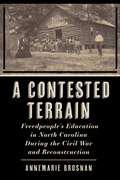
A testament to the resilience and determination of Black North Carolinians to achieve educational equalityThis book examines the educational experiences…
of Black North Carolinians during the American Civil War and Reconstruction period, 1861–1877. By highlighting the collaborative efforts that led to the growing network of schools for the formerly enslaved people, it argues that schooling the Freedpeople was a contested terrain, fraught with conflicting visions of Black freedom and the role education should play. Although Black men and women emerged as the driving force behind the educational endeavors of this period, their work was facilitated by Northern aid and missionary societies, the federally-mandated Freedmen’s Bureau, and over 1,400 teachers from various regional and racial backgrounds. Yet the educational landscape was far from uniform, and the individuals and organizations involved had their distinct visions regarding the nature and purpose of Freedpeople’s education.Through the use of qualitative and quantitative research methods, this book offers new insights into the reasons why Black and white Northerners and Southerners elected to become teachers. By examining their diverse motivations and experiences, it argues that attitudes toward Freedpeople’s education were complex and fluid, defying neat characterization.Despite mounting obstacles and opposition to their work, Black North Carolinians’ unrelenting quest for education ultimately gave rise to free public schooling for both races, the professionalization of Black teachers, and an extensive network of Historically Black Colleges and Universities.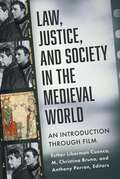
Par Esther Liberman Cuenca, M. Christina Bruno, and Anthony Perron. 2025
This coursebook is the first full-length study of cinematic “legal medievalism,” or the modern interpretation of medieval law in film…
and popular cultureFor more than a century, filmmakers have used the “Middle Ages” to produce popular entertainment and comment on contemporary issues. Each of the twenty chapters in Law, Justice, and Society in the Medieval World represents an original contribution to our understanding of how medieval regulations, laws, and customs have been depicted in film. It offers a window into the “rules” of medieval society through the lens of popular culture.This book includes analyses of recent and older films, avant-garde as well as popular cinema. Films discussed in this book include Braveheart (1995), Kingdom of Heaven (2005), The Passion of Joan of Arc (1928), The Last Duel (2021), The Green Knight (2021), The Little Hours (2017), and The Adventures of Robin Hood (1938), among others.Each chapter explores the contemporary context of the film in question, the medieval literary or historical milieu the film references, and the lessons the film can teach us about the medieval world. Attached to each chapter is an appendix of medieval documentary sources and reading questions to prompt critical reflection.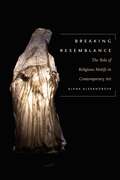
Par Alena Alexandrova. 2017
In recent decades curators and artists have shown a distinct interest in religion, its different traditions, manifestations in public life,…
gestures and images. Breaking Resemblance explores the complex relationship between contemporary art and religion by focusing on the ways artists re-work religious motifs as a means to reflect critically on our desire to believe in images, on the history of seeing them, and on their double power— iconic and political. It discusses a number of exhibitions that take religion as their central theme, and a selection of works by Bill Viola, Lawrence Malstaf, Victoria Reynolds, and Berlinde de Bruyckere—all of whom, in their respective ways and media, recycle religious motifs and iconography and whose works resonate with, or problematize the motif of, the true image.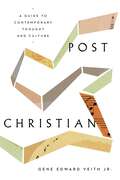
Par Gene Edward Veith Jr.. 2020
Undaunted Hope in a Post-Christian World We live in a post-Christian world. Contemporary thought—claiming to be “progressive” and “liberating”—attempts to…
place human beings in God’s role as creator, lawgiver, and savior. But these post-Christian ways of thinking and living are running into dead ends and fatal contradictions. This timely book demonstrates how the Christian worldview stands firm in a world dedicated to constructing its own knowledge, morality, and truth. Gene Edward Veith Jr. points out the problems with how today’s culture views humanity, God, and even reality itself. He offers hope-filled, practical ways believers can live out their faith in a secularist society as a way to recover reality, rebuild culture, and revive faith.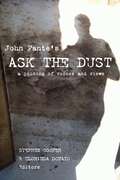
Par Stephen Cooper and Clorinda Donato. 2020
This volume assembles for the first time a staggering multiplicity of reflections and readings of John Fante’s 1939 classic, Ask…
the Dust, a true testament to the work’s present and future impact.The contributors to this work—writers, critics, fans, scholars, screenwriters, directors, and others—analyze the provocative set of diaspora tensions informing Fante’s masterpiece that distinguish it from those accounts of earlier East Coast migrations and minglings. A must-read for aficionados of L.A. fiction and new migration literature, John Fante’s “Ask the Dust”: A Joining of Voices and Views is destined for landmark status as the first volume of Fante studies to reveal the novel’s evolving intertextualities and intersectionalities.Contributors: Miriam Amico, Charles Bukowski, Stephen Cooper, Giovanna DiLello, John Fante, Valerio Ferme, Teresa Fiore, Daniel Gardner, Philippe Garnier, Robert Guffey, Ryan Holiday, Jan Louter, Chiara Mazzucchelli, Meagan Meylor, J’aime Morrison, Nathan Rabin, Alan Rifkin, Suzanne Manizza Roszak, Danny Shain, Robert Towne, Joel Williams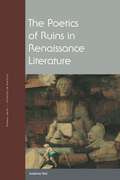
Par Andrew Hui. 2017
The Renaissance was the Ruin-naissance, the birth of the ruin as a distinct category of cultural discourse, one that inspired…
voluminous poetic production. For humanists, the ruin became the material sign that marked the rupture between themselves and classical antiquity. In the first full-length book to document this cultural phenomenon, Andrew Hui explains how the invention of the ruin propelled poets into creating works that were self-aware of their absorption of the past as well as their own survival in the future.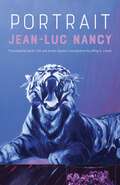
Par Jean-Luc Nancy. 2018
This book examines the practice of portraits as a way in to grasping the paradoxes of subjectivity. To Nancy, the…
portrait is suspended between likeness and strangeness, identity and distance, representation and presentation, exactitude and forcefulness. It can identify an individual, but it can also express the dynamics by means of which its subject advances and withdraws.The book consists of two extended essays written a decade apart but in close conversation, in which Nancy considers the range of aspirations articulated by the portrait. Heavily illustrated, it includes a newly written preface bringing the two essays together and a substantial Introduction by Jeffrey Librett, which places Nancy’s work within the range of thinking of aesthetics and the subject, from religion, to aesthetics, to psychoanalysis.Though undergirded by a powerful grasp of the philosophical and psychoanalytic tradition that has rendered our sense of the subject so problematic, Nancy’s book is at heart a delightful, unpretentious reading of three dozen portraits, from ancient drinking mugs to recent experimental or parodic pieces in which the artistic representation of a sitter is made from their blood, germ cultures, or DNA.The contemporary world of ubiquitous photos, Nancy argues, in no way makes the portrait a thing of the past. On the contrary, the forms of appearing that mark the portrait continue to challenge how we see the bodies and representations that dominate our world.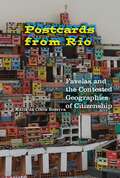
Par Kátia Da Bezerra. 2017
Through the analysis of a variety of favela-based visual cultural productions by young people and contemporary theorists, Postcards from Rio…
examines the complex relationship between citizenship and urban space in contemporary Rio de Janeiro.By analyzing videos and photographs, Kátia da Costa Bezerra illustrates how citizens of favelas are reshaping their sense of belonging as subjects and as a legitimate part of the city. A groundbreaking study that examines more deeply the relationship between urban space, citizenship, and imagery originating in the favelas, Postcards from Rio sheds crucial light on how contemporary lenses are defining and mediating the meanings of space and citizenship as strategies of empowerment. The city emerges as a political space where multiplicities of perspectives are intertwined with demands for more inclusive forms of governance.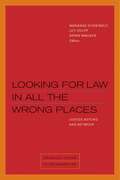
Par Wendy Brown, Saba Mahmood, Daniel Boyarin, Christopher Tomlins, Samera Esmeir, Ramona Naddaff, Kathryn Abrams, Sara Ludin, Sarah Song, Rebecca M. McLennan, Bath H. Piatote, Daniel Fisher. 2019
For many inside and outside the legal academy, the right place to look for law is in constitutions, statutes, and…
judicial opinions. This book looks for law in the “wrong places”—sites and spaces in which no formal law appears. These may be geographic regions beyond the reach of law, everyday practices ungoverned or ungovernable by law, or works of art that have escaped law’s constraints.Looking for Law in All the Wrong Places brings together essays by leading scholars of anthropology, cultural studies, history, law, literature, political science, race and ethnic studies, religion, and rhetoric, to look at law from the standpoint of the humanities. Beyond showing law to be determined by or determinative of distinct cultural phenomena, the contributors show how law is itself interwoven with language, text, image, and culture.Many essays in this volume look for law precisely in the kinds of “wrong places” where there appears to be no law. They find in these places not only reflections and remains of law, but also rules and practices that seem indistinguishable from law and raise challenging questions about the locations of law and about law’s meaning and function. Other essays do the opposite: rather than looking for law in places where law does not obviously appear, they look in statute books and courtrooms from perspectives that are usually presumed to have nothing to say about law.Looking at law sideways, or upside down, or inside out defamiliarizes law. These essays show what legal understanding can gain when law is denied its ostensibly proper domain.Contributors: Kathryn Abrams, Daniel Boyarin, Wendy Brown, Marianne Constable, Samera Esmeir, Daniel Fisher, Sara Ludin, Saba Mahmood, Rebecca McLennan, Ramona Naddaff, Beth Piatote, Sarah Song, Christopher Tomlins, Leti Volpp, Bryan Wagner